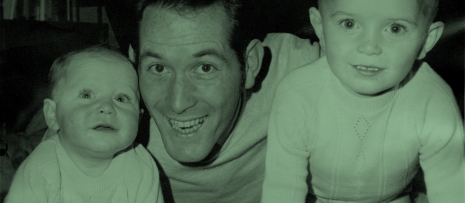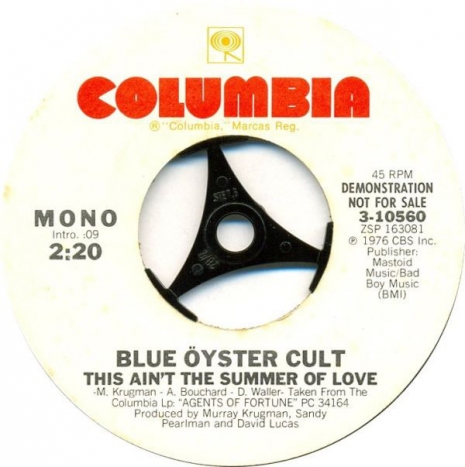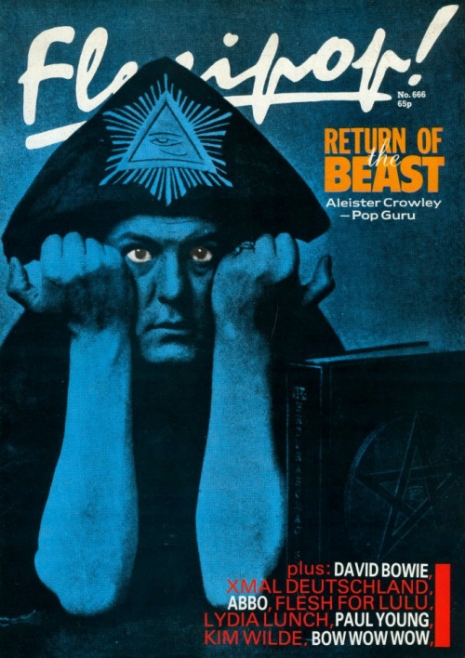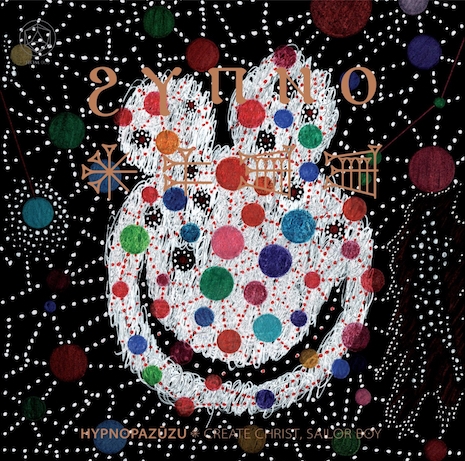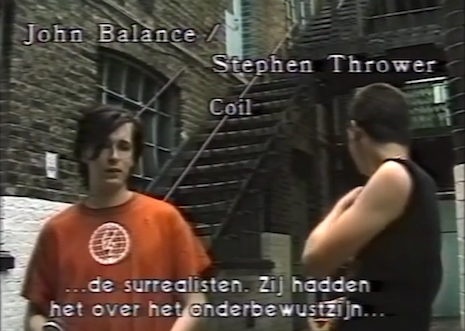
David Tibet’s cover for Create Christ, Sailor Boy
My main impression of Create Christ, Sailor Boy is of its grandeur—not so much in the sense that it’s musically fancy, but more that it has the dignity and courage of a bravura theatrical performance. Where recent Current 93 records have presented David Tibet’s voice as vulnerable, or naked, on Hypnopazūzu’s first release he sings out, summoning a voice he acknowledges he hasn’t used much before, if at all. Youth’s sound-world draws it from him: Here, that means the mad scientist of Space Mountain is using a psychedelic orchestra of strings, bells, horns, synths, tamburas and God knows what else to play compositions that draw equally on 20th-century art music and raga-rock. But all you really need to know is that the album is gorgeous and moving, for which reasons I hereby declare Hypnopazūzu “the hottest new group of 2016.”
Tibet and Youth are two of my musical heroes, as my long-suffering friends will attest; to ride in my car is to enjoy Youth’s Killing Joke in Dub and Current 93’s Aleph at Hallucinatory Mountain at high volume. So when I learned of Hypnopazūzu, I immediately began writing sweaty-handed emails to their publicist.
This is Tibet and Youth’s first collaboration since Youth played bass on Current 93’s first LP, Nature Unveiled, released in 1984. (Get the Andrew Liles remix before they’re all gone.) Since the last person I interviewed for Dangerous Minds, Little Annie, also appeared on C93’s debut, I started by asking about that 32-year-old apocalypse.
(When they weren’t busy kicking members of Hypnopazūzu off the conversation, Skype gremlins were hard at work garbling Tibet’s bons mots. I had to resort to “[inaudible]” more than once.)

Dangerous Minds: Coincidentally, the last person I interviewed was Little Annie. So I feel I ought to bring up Nature Unveiled, since I’ve now spoken to so many of the participants in the session. What do you remember about it?
David Tibet: Me, or Youth?
Both of you, since you both participated.
Youth: Let David go first, because it’s his album, really, that I guested on.
Tibet: Well, that’s a shame, because I’d always thought of it as Youth’s album, and I’d wanted to put it out as Youth, featuring me.
Youth: [laughs] I remember the studio in Shepherd’s Bush.
Tibet: Yeah, the studio was a really weird place. It was called IPS, as in “inches per second,” and it was run by a guy called… Pete. Pete something. And the odd thing about it was, Steve Stapleton from Nurse With Wound used to work there, and when I became friends with Steven, he said, “Oh, come and join Nurse With Wound and come down to this studio.” So I went down there. It was in the basement. And we worked there for years. Steve actually had—I think it was Wednesday—every Wednesday booked for something like [inaudible] years in advance, we would go down there on Wednesday. And then the last time I went down there, just before it closed, all the sewers had backed up, and so there was urine everywhere, and other stuff which I didn’t choose to identify. But it was a great studio.
But the bizarre thing is that I was down there getting things ready for Youth, and there was a guy in the studio, working there. And he said, “Oh, what are you doing?” And I said, “I’m working on a new album; I’m waiting for my friend to come down.” And it was Jaz [Coleman], from Killing Joke.
Youth: That’s right! He was walking out as I was walking in. [laughs]
Tibet: It was a time when Youth wasn’t, uh—well, you had—
Youth: I’d left the band, yeah.
Tibet: —you’d left the band, and you were very uncomplimentary about [each other]. But I didn’t know who he was at first, because I thought you said he was working [in] jazz. [inaudible] And I thought, Oh, that sounds horrible.
Youth: There was some serendipity.
Tibet: [laughs] It was just bizarre, looking back. But Youth and I met, I think—it must have been through Kris Needs, mustn’t it?
Youth: And Mark Manning, Zodiac.
Tibet: I think I met Mark through Kris, or Kris through Mark, and then I met Youth. And we used to go clubbing.
Youth: I was sharing a coach house with Kris at the time.
Tibet: You were! Yeah.
Youth: And we were all going down to the Batcave. And also, I’d just done this album with Ben Watkins on Illuminated, The Empty Quarter, just around that time. And Zed had done the artwork; Zed had been doing the layout for Smash Hits. Weren’t you doing something for Smash Hits as well, David?
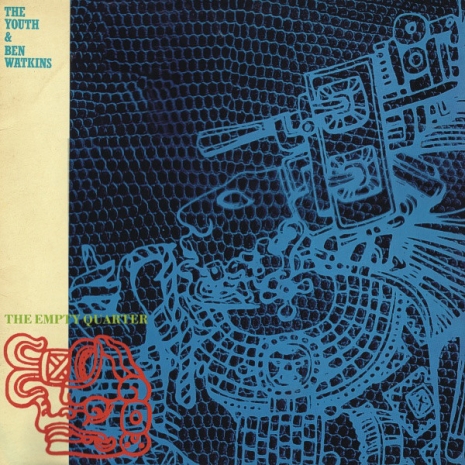
Youth and Ben Watkins’ The Empty Quarter
Tibet: Yes. Oliver, Zed is Mark Manning, became Zodiac Mindwarp, and that’s who Youth means, I believe, as Zed.
Youth: Yeah.
Tibet: I wrote an article on Crowley for them.
Youth: That’s right! The Crowley edition. They had Crowley on the front cover of this pop magazine.
Was there a special issue of Smash Hits?
Tibet: It was their last issue, and I said “It has to be number 666.”
Youth: [laughs]
Tibet: And it had an interview, I remember, I think in that same issue, with, there was a band called—oh gosh, what were they called? They were a new goth band or positive punk or something, and the guy who was interviewed was interested in Crowley. And then they spoke about somebody that had been killed who was interested in Crowley, who was knocked over in a car accident, and they said to the guy, “What do you think about that?” And he said: “Well, it’s love under wheels.” Which I thought was pretty funny, but I can’t remember the name of the band.
Youth: Good name for a band.
Tibet: Yeah. That’s how Youth and I met. Then I said to Youth, “I’m doing my first album,” and Youth probably looked at me and said, “Who are you again?” And I said, “I’m a friend of yours; we go clubbing, and doing other things that go with clubbing, together.” And then he kindly came down and played amazing bass, and Annie was there swearing in Spanish, and then Youth and I didn’t see each other for… 30 years or so.
Youth: Yeah. That’s right. But I did know who you were, because Zed had been hanging around Sleazy, he’d had his penis pierced by Sleazy and was hanging around the Psychic TV clique of people. There were interesting, alchemizing scenes at the time that were all coming together, and weirdly enough, the Batcave was one of the nexus points. Not just for goths and punks, but also the emerging New Romantics and electronic scenes that were bouncing up. And—
Tibet: It was the guy from Doctor and the Medics. Was it Clive?
Youth: Oh, that was Alice and Wonderland, wasn’t it. That came after the Batcave.
Tibet: Then that was Olli from the Specimen.
Youth: Yes, yes, yes.
Tibet: ‘Cause they got loads of bands to play there. I mean, I saw the Jesus and Mary Chain there before they were—I think that was the same show that Alan McGee saw which made him want to sign them.
Youth: At the Batcave?
Tibet: Yeah, definitely.
Youth: Really? I don’t remember that. But I do remember the club was more based around DJs than bands, with Hamish and Sex Beat. It would go on until two in the morning, so the DJs carried on. It was the dance floor in that club where I thought, this is the sort of beginning of indie dance, really. There was a real special chemistry and alchemy going on there. Lots of ideas came out of that place, and Alice in Wonderland, actually. There’s a new Derek Ridgers book, actually. You know Derek, the photographer who was around those clubs all the time?
Tibet: No, I don’t remember that, no.
Youth: He always looked a bit straight, and he had a beard, but he was doing everything—the S&M clubs, everything. And he’s got a new book out where there’s pictures of me and Zed, I think you might even be in it, from the Batcave in those days.
Tibet: No, I don’t remember him at all. I do remember it wasn’t Sleazy that pierced Zed, it was Mr. Sebastian.
Youth: Ah.
Tibet: Because recently I got a lot of footage of Mr. Sebastian in action. And I was hoping Zed would be there, because I remember, I was actually down there when Zed was pierced—
Youth: Really!
Tibet: But yeah, the footage wasn’t there. There was other footage, which I’ll be releasing soon if people don’t [inaudible] making huge amounts of money.
Youth: Did he have a semi-chub on, or was it just flaccid?
[laughter]
Tibet: I can’t remember! I was young; I was too busy admiring myself in the mirror, probably.
Youth: Zed’s got a legendarily big dick, goes down to his knee.
Tibet: I heard about that, and Sleazy told me about that, but I—
Youth: I gone on holiday with Zed, the first time he’d ever been on a plane, and I took him to Formentera in Ibiza when we were 21. And we woke up on this nudist beach, totally naked, and the ring in his cock had heated up in the sun [laughs] and he’s fallen asleep and woken up in agony.
And then he had these eagle wings coming out the top of it, tattooed, right? So he’s coming out of the sea with his snorkel and flip-flops, with massive dick dangling between his knees, his eagle wings and a big ring hanging out of it—and all these German families just gathered their children and ran to the other end of the beach. [laughter]
Tibet: Those were the days.
More after the jump…









